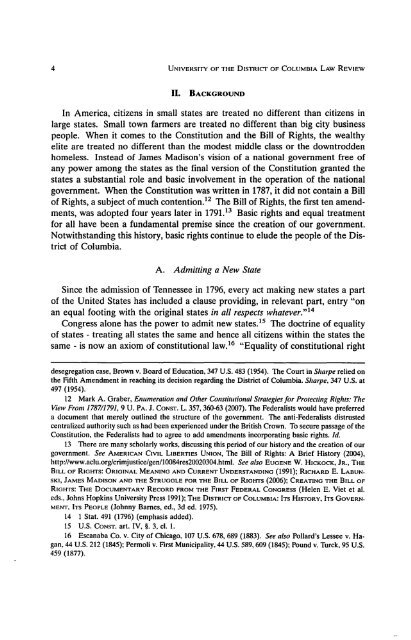Download - UDC Law Review
Download - UDC Law Review
Download - UDC Law Review
You also want an ePaper? Increase the reach of your titles
YUMPU automatically turns print PDFs into web optimized ePapers that Google loves.
4 UNIVERSITY OF THE DISTRICT OF COLUMBIA LAW REVIEWII. BACKGROUNDIn America, citizens in small states are treated no different than citizens inlarge states. Small town farmers are treated no different than big city businesspeople. When it comes to the Constitution and the Bill of Rights, the wealthyelite are treated no different than the modest middle class or the downtroddenhomeless. Instead of James Madison's vision of a national government free ofany power among the states as the final version of the Constitution granted thestates a substantial role and basic involvement in the operation of the nationalgovernment. When the Constitution was written in 1787, it did not contain a Billof Rights, a subject of much contention. 12 The Bill of Rights, the first ten amendments,was adopted four years later in 1791. 13 Basic rights and equal treatmentfor all have been a fundamental premise since the creation of our government.Notwithstanding this history, basic rights continue to elude the people of the Districtof Columbia.A. Admitting a New StateSince the admission of Tennessee in 1796, every act making new states a partof the United States has included a clause providing, in relevant part, entry "onan equal footing with the original states in all respects whatever.,,14Congress alone has the power to admit new states. IS The doctrine of equalityof states - treating all states the same and hence all citizens within the states thesame - is now an axiom of constitutional law. 16 "Equality of constitutional rightdesegregation case, Brown v. Board of Education, 347 U.S. 483 (1954). The Court in Sharpe relied onthe Fifth Amendment in reaching its decision regarding the District of Columbia. Sharpe, 347 U.S. at497 (1954).12 Mark A. Graber, Enumeration and Other Constitutional Strategies for Protecting Rights: TheView From 178711791, 9 U. PA. J. CONST. L. 357, 360-63 (2007). The Federalists would have preferreda document that merely outlined the structure of the government. The anti-Federalists distrustedcentralized authority such as had been experienced under the British Crown. To secure passage of theConstitution, the Federalists had to agree to add amendments incorporating basic rights. [d.13 There are many scholarly works. discussing this period of our history and the creation of ourgovernment. See AMERICAN CIVIL LIBERTIES UNION, The Bill of Rights: A Brief History (2004),http://www.aclu.org/crimjustice/gen/10084res20020304.html. See also EUGENE W. HICKOCK, JR., THEBILL OF RIGHTS: ORIGINAL MEANING AND CURRENT UNDERSTANDING (1991); RICHARD E. LABUN.SKI, JAMES MADISON AND THE STRUGGLE FOR THE BILL OF RIGHTS (2006); CREATING THE BILL OFRIGHTS: THE DOCUMENTARY RECORD FROM THE FIRST FEDERAL CONGRESS (Helen E. Viet et al.eds., Johns Hopkins University Press 1991); THE DISTRICT OF COLUMBIA: ITS HISTORY, ITS GOVERN.MENT. ITs PEOPLE (Johnny Barnes, ed., 3d ed. 1975).14 1 Stat. 491 (1796) (emphasis added).15 U.S. CONST. art. IV. §. 3, cl. 1.16 Escanaba Co. v. City of Chicago, 107 U.S. 678, 689 (1883). See also Pollard's Lessee v. Hagan,44U.S. 212 (1845); Permoli v. First Municipality, 44 U.S. 589, 609 (1845); Pound v. Turck, 95 U.S.459 (1877).














